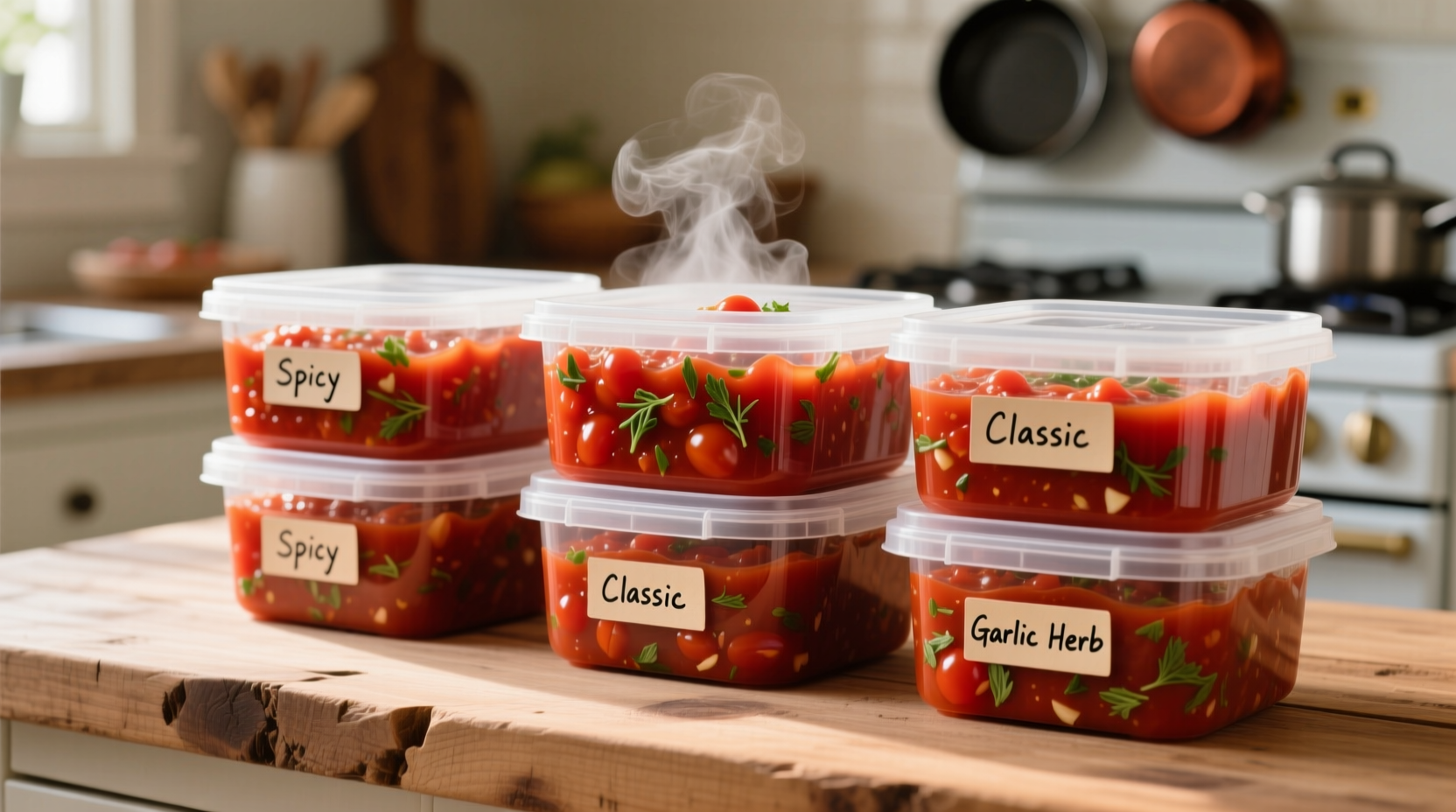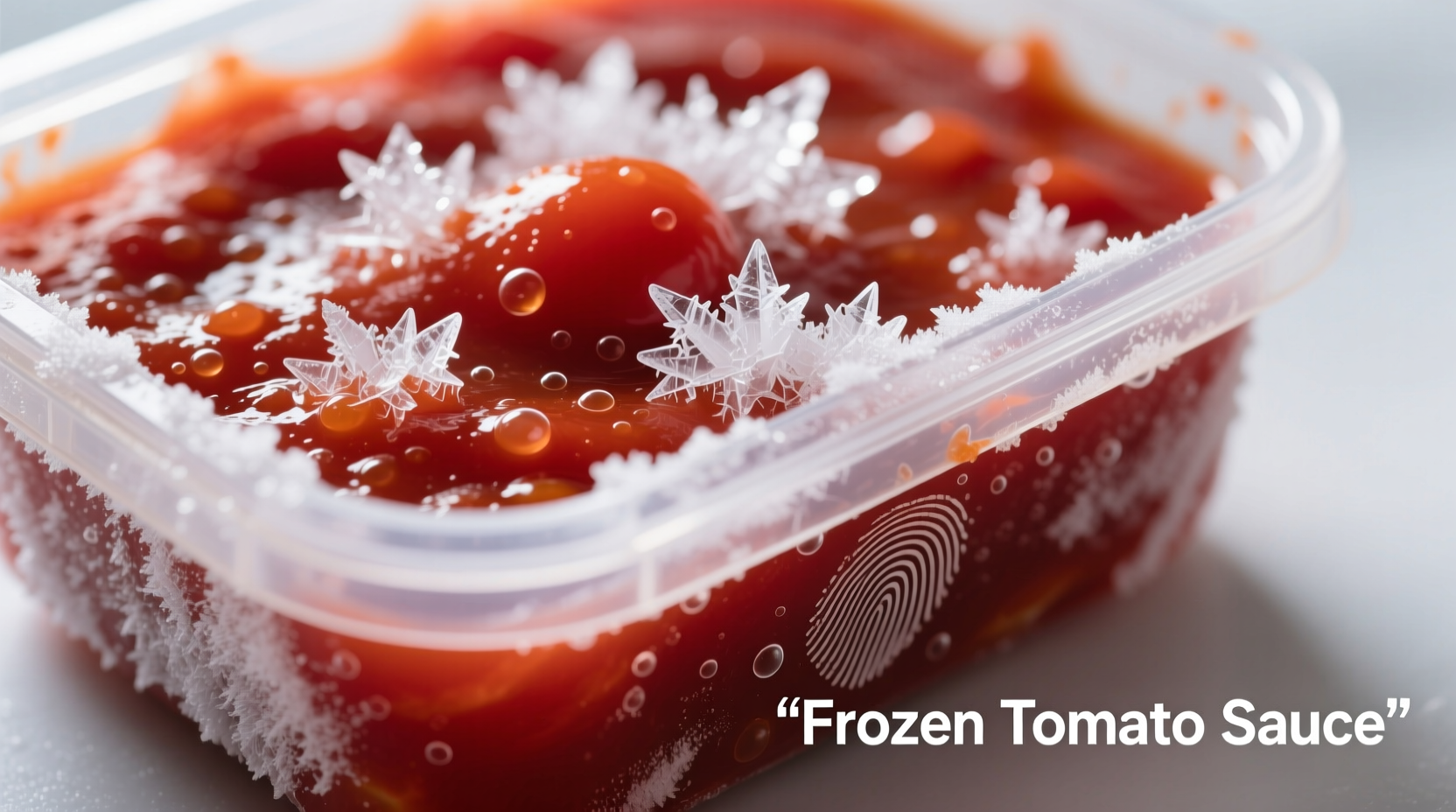Have you ever made a big batch of marinara only to realize you can't possibly use it all before it spoils? Or perhaps you scored an amazing deal on canned tomatoes and want to preserve your homemade sauce for future meals? Freezing tomato sauce properly solves both problems, extending its shelf life while preserving that fresh-cooked flavor you worked so hard to achieve.
The Science Behind Freezing Tomato Sauce Successfully
Tomato sauce freezes exceptionally well due to its high water content and natural acidity. According to the FDA Food Code, properly frozen foods maintain safety indefinitely at 0°F (-18°C), though quality considerations determine the optimal storage duration. The key to maintaining texture and flavor lies in understanding how freezing affects the sauce's components.
When tomato sauce freezes, ice crystals form that can potentially break down the sauce's structure. Professional chefs combat this by controlling two critical factors: cooling rate and container selection. Rapid freezing creates smaller ice crystals that cause less damage to the sauce's cellular structure, preserving texture upon thawing.
Step-by-Step Freezing Process: From Pot to Freezer
Follow these professional-tested steps to freeze tomato sauce with restaurant-quality results every time:
1. Cool Your Sauce Properly (Critical First Step)
Never put hot sauce directly into the freezer. The USDA Food Safety and Inspection Service recommends cooling cooked foods from 140°F to 70°F within 2 hours, and from 70°F to 40°F within an additional 2 hours to prevent bacterial growth. For tomato sauce:
- Transfer hot sauce to a clean metal bowl (metal conducts heat better than ceramic or glass)
- Place the bowl in an ice water bath, stirring occasionally
- Cool to room temperature within 1-2 hours before portioning
2. Portion for Practical Use
Freeze sauce in portions matching your typical usage:
- Single servings: 1-2 cups (perfect for individual pasta dishes)
- Family meals: 4 cups (standard for most family-sized pasta recipes)
- Recipe building blocks: 1 cup (ideal for soups, stews, and casseroles)
3. Select the Right Freezer Container
Not all containers perform equally in the freezer. Based on testing by the National Center for Home Food Preservation, here's how common options compare:
| Container Type | Freezer Storage Time | Texture Preservation | Air Exposure Risk |
|---|---|---|---|
| Freezer-safe glass jars | 4-6 months | Excellent | Low (when properly filled) |
| Rigid plastic containers | 4-6 months | Very Good | Low |
| Freezer bags (stand-up) | 3-4 months | Good | Moderate |
| Regular plastic containers | 2-3 months | Fair | High |
Pro tip: Leave ½ inch of headspace in rigid containers to allow for expansion during freezing. For freezer bags, lay flat on a baking sheet to freeze in uniform rectangles that stack efficiently.
4. Label with Critical Information
Every container should include:
- Date of freezing (use the "first in, first out" principle)
- Type of sauce ("Marinara," "Arrabbiata," "Vodka Sauce")
- Key ingredients (helpful if you've added wine, cream, or meat)
Freezer Timeline: When Quality Begins to Decline
While frozen foods remain safe indefinitely, quality diminishes over time. Based on research from the USDA Agricultural Research Service, here's what to expect:
- 0-2 months: Near-fresh quality, minimal texture changes
- 2-4 months: Slight texture changes, flavor remains excellent
- 4-6 months: Noticeable texture changes, still flavorful but best for cooked applications
- 6+ months: Significant texture degradation, potential freezer burn, use only in heavily seasoned dishes
Thawing and Reheating: Preserving Maximum Flavor
The way you thaw and reheat frozen sauce dramatically impacts final quality:
Safe Thawing Methods
- Refrigerator method (best): Transfer container from freezer to refrigerator 24-48 hours before use
- Cold water method (faster): Submerge sealed container in cold water, changing water every 30 minutes
- Direct cooking (for soups/stews): Add frozen sauce directly to simmering liquid
Never thaw tomato sauce at room temperature, as this creates ideal conditions for bacterial growth in the temperature danger zone (40°F-140°F).
Reheating for Restaurant-Quality Results
Once thawed, reheat sauce gently to preserve texture:
- Warm over medium-low heat, stirring occasionally
- Avoid rapid boiling which can cause separation
- If sauce appears thin after thawing, simmer uncovered for 5-10 minutes to reduce
- Add a splash of fresh olive oil or butter at the end to restore richness

When NOT to Freeze Tomato Sauce: Critical Limitations
While freezing works well for most tomato sauces, certain variations don't freeze successfully:
- Cream-based sauces: Dairy separates upon thawing (freeze base without cream, add when reheating)
- Sauces with fresh herbs: Delicate herbs like basil lose flavor (add fresh herbs after reheating)
- Sauces with potatoes or pasta: These ingredients become mushy when frozen and thawed
- Sauces showing spoilage signs: Never freeze sauce that's already past its prime
According to food safety guidelines from the USDA Food Safety and Inspection Service, if your sauce shows any signs of spoilage before freezing—such as mold, off odors, or unusual texture—it should be discarded immediately and not frozen.
Troubleshooting Common Freezing Issues
Problem: Sauce Separates After Thawing
Solution: This happens when oil separates from the tomato base. Simply whisk vigorously while reheating. Adding an emulsifier like 1 teaspoon of tomato paste per cup of sauce before freezing prevents this issue.
Problem: Sauce Tastes Watery After Thawing
Solution: Excess water forms as ice crystals melt. Simmer uncovered for 5-10 minutes to reduce and concentrate flavors. Next time, reduce your sauce slightly thicker before freezing.
Problem: Freezer Burn Appears
Solution: Freezer burn indicates air exposure. While safe to eat, affected portions may have off-flavors. Trim away affected areas. For future batches, ensure containers are airtight and remove excess air from freezer bags.
Maximizing Flavor in Frozen Tomato Sauce
Professional chefs use these techniques to ensure frozen sauce tastes as vibrant as freshly made:
- Add extra garlic and herbs before freezing—they mellow during storage
- Include umami boosters like tomato paste or Parmesan rinds
- Freeze sauce in ice cube trays first, then transfer to bags (perfect for adding small amounts to dishes)
- Leave acid-sensitive ingredients (like wine) until reheating for brightest flavor
Frequently Asked Questions
Can you freeze store-bought tomato sauce in the original jar?
No, glass jars aren't designed for freezing and may shatter as contents expand. Transfer store-bought sauce to freezer-safe containers, leaving ½ inch of headspace. Metal cans should also be emptied before freezing, as the lining may degrade.
How do you prevent ice crystals in frozen tomato sauce?
Minimize ice crystals by cooling sauce rapidly before freezing, using airtight containers with minimal air space, and maintaining a consistent freezer temperature at 0°F (-18°C) or below. Freezing in thin, flat portions also creates smaller, less damaging ice crystals.
Can you freeze tomato sauce with meat?
Yes, meat-based tomato sauces freeze well for 4-6 months. Ensure meat is fully cooked before adding to sauce. For best quality, freeze meat and sauce separately then combine when reheating, as meat can become slightly dry when frozen with liquid.
Does freezing affect the acidity of tomato sauce?
Freezing doesn't significantly alter the pH of tomato sauce. Properly frozen sauce maintains its natural acidity, which is why it freezes so well compared to low-acid foods. The USDA confirms that freezing preserves the chemical properties of high-acid foods like tomato products.
Can you refreeze tomato sauce after thawing?
Only if the sauce was thawed in the refrigerator and remained below 40°F. Sauce thawed using cold water or microwave methods should be used immediately and not refrozen. Each freeze-thaw cycle degrades texture and increases food safety risks.











 浙公网安备
33010002000092号
浙公网安备
33010002000092号 浙B2-20120091-4
浙B2-20120091-4